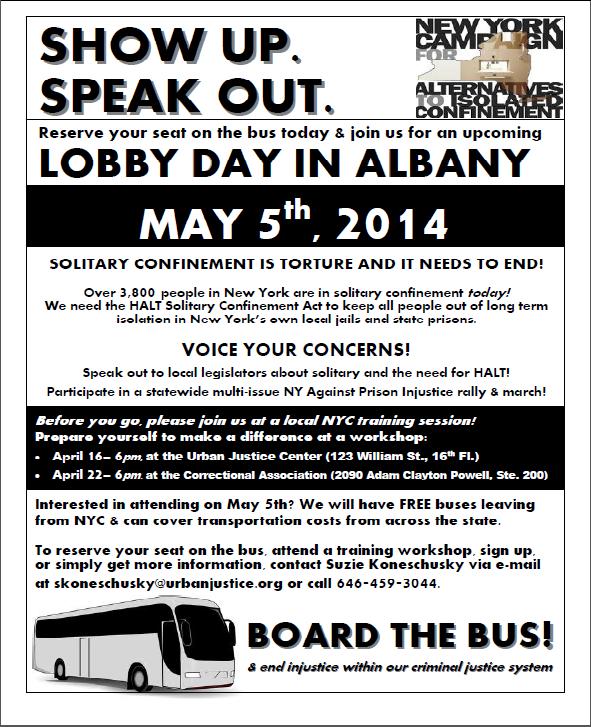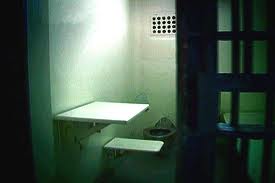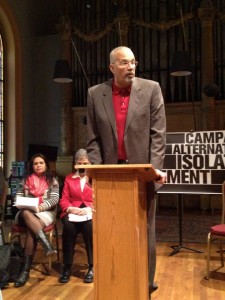Press Release from the New York Campaign for Alternatives to Isolated Confinement
 Albany, May 5, 2014 — At a mid-morning press conference in the Legislative Office Building in Albany, leading legislators joined advocates, people who had experienced solitary confinement, and family members of those currently in solitary to promote the Humane Alternatives to Long-Term (HALT) Solitary Confinement Act (A08588A / S06466A).
Albany, May 5, 2014 — At a mid-morning press conference in the Legislative Office Building in Albany, leading legislators joined advocates, people who had experienced solitary confinement, and family members of those currently in solitary to promote the Humane Alternatives to Long-Term (HALT) Solitary Confinement Act (A08588A / S06466A).
At the same time, more than 120 individuals from across the state, many of them directly affected by the widespread use of solitary confinement in New York, gathered for an inaugural lobby day at the State Capitol, meeting with more than 50 legislators.
After years of activism by human rights and civil liberties groups, faith communities, currently and formerly incarcerated people, and other concerned citizens, solitary confinement is currently exploding as an issue, both in the media and on public policy agendas.
Supporters are hailing the HALT Solitary Confinement Act as the most comprehensive and progressive legislative response to date to the nationwide problem of solitary confinement in prisons and jails. As written, it would virtually eliminate a practice that has been increasingly denounced as both dangerous and torturous, while protecting the safety of incarcerated individuals and corrections officers.
According to Assembly Member Jeffrion Aubry, who is sponsoring the bill in the Assembly, “New York State was a leader for the country in passing the 2008 SHU Exclusion Law, which keeps people with the most severe mental health needs out of solitary confinement. Now we must show the way forward again, ensuring that we provide safe, humane and effective alternatives to solitary for all people.”
“Solitary confinement makes people suffer without making our prisons safer. It is counter-productive as well as cruel,” said Senator Bill Perkins, the bill’s Senate sponsor. “Solitary harms not only those who endure it, but families, communities, and corrections staff as well.”
Additional sponsors of the bill include Ruth Hassell-Thompson, Brad Hoylman, Velmanette Montgomery, N. Nick Perry, and John L. Sampson.
On any given day, about 3,800 people are in Special Housing Units, or SHUs, with many more in other forms of isolated confinement in New York’s State prisons. They are held for 23 to 24 hours in cells smaller than the average parking space, alone or with one other person. More than 800 are in solitary confinement in New York City jails, along with hundreds more in local jails across the state.
New York isolates imprisoned people at levels well above the national average, and uses solitary to punish minor disciplinary violations. Five out of six sentences that result in placement in New York State’s SHUs are for non-violent conduct. Individuals are sent to the SHU on the word of prison staff, and may remain there for months, years, or even decades.
The HALT Solitary Confinement Act bans extreme isolation beyond 15 days–the limit advocated by UN Special Rapporteur on Torture Juan E. Méndez, among others. Méndez, who is the United Nations’ main torture investigator, has found that solitary confinement as it is practiced in New York violates the U.S.’s international obligations with regard to torture and other forms of cruel, inhuman, and degrading treatment or punishment.
The Special Rapporteur contributed a statement which was read aloud at the press conference, concluding, “The HALT Solitary Confinement Act reflects both safe and effective prison policy and respect for human rights. It should become law in New York State and a model for change across the United States.”
The HALT Solitary Confinement Act goes well beyond the agreement that was recently reached between the New York State Department of Corrections and Community Supervision (DOCCS) and the New York Civil Liberties Union to limit the use of isolation on youth, pregnant women, and people with developmental disabilities. HALT completely bars these and other vulnerable populations from being placed in solitary at all.
For those who present a serious threat to prison safety and need to be separated from the general population for longer periods of time, the legislation creates new Residential Rehabilitation Units (RRUs)–separate, secure units with substantial out-of-cell time, and programs and treatment aimed at addressing the underlying causes of behavioral problems.
“Isolation does not promote positive change in people; it only damages them,” said Megan Crowe-Rothstein of the Urban Justice Center’s Mental Health Project. “By requiring treatment and programs for people who are separated from the prison population for serious misconduct, the legislation requires Corrections to emphasize rehabilitation over punishment and degradation.”
The widespread use of long-term solitary confinement has been under fire in recent years, in the face of increasing evidence that sensory deprivation, lack of normal human interaction, and extreme idleness can lead to severe psychological damage. Supporters of the bill also say that isolated confinement fails to address the underlying causes of problematic behavior, and often exacerbates that behavior as people deteriorate psychologically, physically, and socially.
Rev. Ron Stief of the National Religious Campaign Against Torture said, “The diverse faith traditions represented by NRCAT hold in common a belief in the dignity of each human person. We share a conviction that the use of isolated confinement in U.S. prisons and jails violates basic religious values of community and restorative justice. The HALT Solitary Confinement Act provides New York with a critical opportunity to lead the way nationally in increasing access to rehabilitation and ending the torture of isolated confinement.”
Solitary confinement has never been shown to reduce prison violence. In fact, several state prisons systems, including Maine, Mississippi, and Colorado, have significantly reduced the number of people they hold in solitary confinement, and have seen prison violence decrease as well. In addition, individuals released from solitary confinement have higher recidivism rates. In New York each year, nearly 2,000 people are released directly from extreme isolation to the streets.
“The damage done by solitary confinement is deep and permanent,” said solitary survivor Five Mualimm-ak of the Incarcerated Nation Campaign. Mualimm-ak spent five years in isolated confinement despite never having committed a violent act in prison. “Having humane alternatives will spare thousands of people the pain and suffering that extreme isolation causes–and the scars that they carry with them back into our communities.”
Also speaking at the press conference was hip-hop artist Mysonne, who spent time in solitary in New York, and Jessica Casanova, aunt of a young man currently in solitary.
Many of those represented at the press conference are members of the New York Campaign for Alternatives to Isolated Confinement (CAIC), which was instrumental in drafting the bill. CAIC unites advocates, concerned community members, lawyers, and individuals in the human rights, health, and faith communities throughout New York State with formerly incarcerated people and family members of currently incarcerated people.
On May 5, CAIC members from all corners of New York State were gathering at the State Capitol to lobby legislators to support the HALT Solitary Confinement Act.
“CAIC recognizes that we need a fundamental transformation of how our public institutions address people’s needs and behaviors, both in our prisons and in our communities,” said Scott Paltrowitz of the Correctional Association of New York. “Rather than inhumane and ineffective punishment, deprivation, and isolation, the HALT Act would provide people with greater support, programs, and treatment to help them thrive, and in turn make our prisons and our communities safer.”
Date/Time/ Location:
Monday, May 5, 10:00 – 11:00 am
LCA Press Room, Legislative Office Building, First Floor
198 State Street, Albany
Speakers:
Assembly Member Jeffrion L. Aubry (D, 35th District, Queens),
Assembly sponsor Senator Bill Perkins (D, 30th District, Harlem), Senate sponsor
Five Mualimm-ak, survivor of solitary confinement in New York, Incarcerated Nation Campaign, Campaign for Alternatives to Isolated Confinement (CAIC)
Mysonne, survivor of solitary confinement in New York, hip-hop artist
Jessica Casanova, aunt of individual currently in solitary, CAIC
Scott Paltrowitz, Correctional Association of New York, CAIC
Claire Deroche, National Religious Campaign Against Torture, CAIC
All speakers will be available for interview along with additional family members of individuals in solitary confinement, advocates, and members of the clergy, including Rev. Dr. Paul S. Johnson, Senior Minister, Unitarian Universalist Congregation at Shelter Rock
FOR MORE INFORMATION, CONTACT:
Megan Crowe-Rothstein, 860-214-2348, megan@urbanjustice.org
Jean Casella, 917-974-0529, casellaj4@gmail.com





Follow the #HALTsolitary Campaign